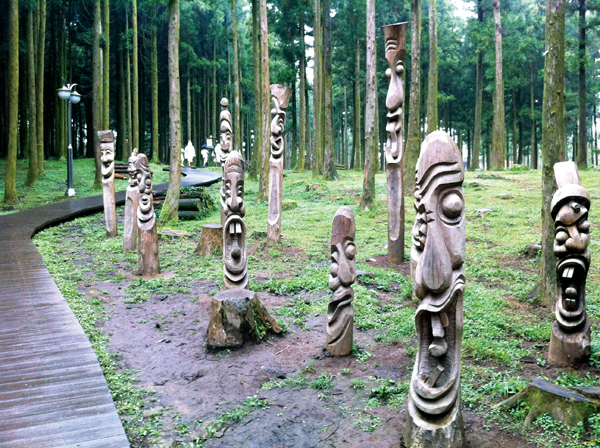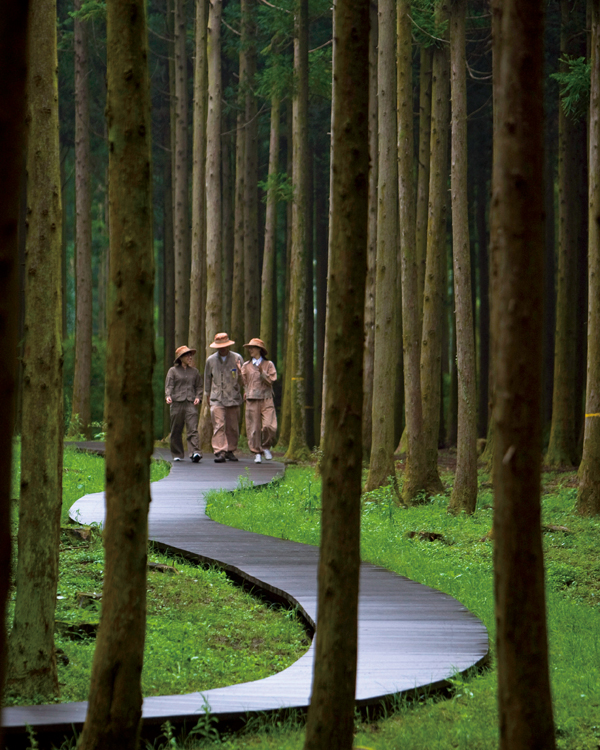| |
 |
|
| ▲ A wooden pathway through the ‘forest of temple water,’ Jeolmul Forest, Myeonglim-ro, Jeju City. Photo by Jean K. Min. |
The Olle trails in recent years have been a darling of the Korean ecotourists and the media alike, and attract over half a million trekkers to the island every year. However, there is another, lesser known, ecotourism haven popular among Korean trekkers here which is much older than Jeju Olle. It is Jeolmul Forest, which means the “forest of temple water.”
While Jeju Olle became popular only in early 2009, more than a year after Suh Myung Sook opened the first trail in September 2007, Jeolmul had already been attracting hundreds of trekkers every day on Jeju. The key attraction of Jeolmul Forest is the so-called “forest bathing.”
Various trees and plants are known to emit over 5,000 volatile substances invariably known as phytoncide. The word, which means “exterminated by the plant,” was coined in 1937 by Dr. Boris P. Tokin, a Russian biochemist. He found that some plants give off active substances that prevent them from rotting or being eaten by insects and animals. The unique properties of phytoncides have led many in Jeju and Korea to believe that they can improve health by immersing themselves in “forest bathing.”
| |
 |
|
| ▲ Park Director Kim Duk Hong. Photo by Jean K. Min |
When Kim Duk Hong first came to Jeolmul on the last day of 2004 as a new head of the park, located in Myeonglim-ro, Jeju City, he found it a shambles. “It was in the middle of winter but cooling fans were still left in the park’s guest rooms,” Kim recalled. “In the summer, the stench of charcoal barbecue was wafting in the forest.” The complete ban of charcoal barbecue was his first act as park head, followed by the expansion of trails from 1 kilometer in 2004 to the current total of over 16 kilometers.
Kim pestered the provincial government every fiscal season for a budget increase, which was needed to retrofit trails and build more guestrooms. Officials were initially sceptical about Kim’s ambition arguing that the park was a non-profit entity. But Kim was unrelenting and has since built 10 more guest rooms in the park, bringing the total to 26. The park currently earns 50 percent of its 700 million won annual revenue from the lodging service with the remaining half coming from admission fees.
Over five years later, Kim’s meticulous effort has paid off with spectacular results. The park saw over 162,000 visitors this summer alone, about a 67 percent increase from the same season last year. Before Kim took the helm, some 75 percent of visitors were local residents. Now, nearly 70 percent of visitors are tourists from the mainland. “Unlike Olle trails,” Kim said, “many of them find that the trails here block the harsh sunlight of the summer.”
At this rate, the park is projected to greet easily over half a million visitors by year’s end. However, Kim plans to cap the number of annual admissions below the half a million mark. “Admitting any more visitors to the park will inevitably harm the delicate balance of the park’s ecosystem,” Kim said.
Ironically, though Jeolmul Forest is loved by trekkers for its natural bounty and subtle healing effect, its creation was due to introduced tree species. In particular, Japanese cedar and cypress, the two prime trees that adorn the trails of the forest, were planted in the island in massive numbers by Japanese colonialists.
| |
 |
|
| ▲ Photo courtesy Jeolmul Forest |
Tall and fast growing, they were useful in protecting tangerines and other delicate crops of the island from the strong winds blowing from the shore. In early 1960s, the Korean government decided to follow the tradition of Japanese colonialists by replanting Japanese cedar and cypress in Jeolmul Forest.
About two thirds of the forest — an estimated 300 hectares — was planted by human hands. While the forest’s original use as an industrial resource is now waning, Jeolmul has been rediscovered again as an ecotourism site, together with the adjacent roe deer observation center popular among family visitors.
For some 40 public servants handling the daily traffic of tourists in the park, the blockbuster success of Jeolmul Forest has been bittersweet news. To cope with the explosion of visitors during the summer peak season, officials often had to work from 7 a.m. to 9 p.m., six days a week. Since the park is a non-profit entity owned by the government, park officials are paid neither incentives nor bonuses, despite the grueling work.
So what made Kim and his team toil at the park this summer? “It is recognition by the public,” Kim said and seems to be fairly good at winning that coveted recognition with his characteristic media-savvy communication skill.
Jeolmul Forest has been frequently covered by the media both in Jeju and Seoul since it started to draw visitors in impressive numbers in recent years.
|






















